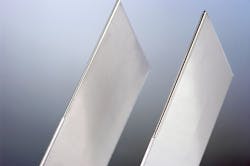NIKOLAUS FECHT
For many years now, lasers have been used to cut sheet metal. Two Aachen, Germany-based research institutes are now tackling a new area for applying lasers in this sector: In the recently launched German Federation of Industrial Research Associations (AiF) project LaserEdge, the Institute of Ferrous Metallurgy (IEHK) at RWTH Aachen University and the Fraunhofer Institute for Laser Technology (Fraunhofer ILT) are investigating how the edges of metallic sheets can be deburred and how process-related crack formation can be prevented (FIGURE).
The AiF has set its sights on small- and medium-sized enterprises (SMEs). This is why the association primarily promotes joint research, the results of which help SMEs work more economically and efficiently. It is precisely this target group at which the AiF project LaserEdge is aimed. Within two years, it plans to establish a laser-based process for refining the edges of components made of cold-formable, high-strength sheet metal, among other materials. To this end, Fraunhofer ILT and IEHK want to identify the process window and limits of laser edge refinement and determine the mechanical properties to be set as a function of the process parameters.
Expertise of experienced ‘laser polishers’
It is no coincidence that Dr. Edgar Willenborg is involved in the project. An expert in the field of laser polishing, Willenborg heads a research team of seven scientists at Fraunhofer ILT who are intensively working on laser-based deburring and polishing. The pressure to innovate is high: Although punching and laser cutting are constantly being improved, neither process is yet perfect. As a typical user in the industry put it, “There is always something left behind when cutting and separating sheet metal parts—something that needs to be removed.” Deburring and polishing processes perform these tasks.
Lack of systematic investigations
Burrs and other edge defects are unpopular with sheet metal processors because they worsen the sheet’s mechanical properties. This, in turn, impairs cold formability and leads to fatigue cracks in the material, both of which can result in component failure. Moreover, sharp edges increase the risk of injury to people and endanger the functionality of components. Although there is much to be said for the use of lasers for deburring, there has not yet been a systematic investigation of how process parameters affect the properties of the component.
Finishing edges of high-strength steel
“The basic principle is simple,” explains Willenborg. “The laser beam is slightly wider than the edge to be processed. The sheet melts over its entire thickness and the surface tension ensures that the melt absorbs the burr.” The secret lies in the correct setting of the process parameters: At low intensity, the corners are slightly rounded, while at higher intensity, a semicircle or even a mushroom profile can be created to reinforce the edges. When developing the process parameters, researchers at Fraunhofer ILT have to pay special attention to the tradeoff between rounded edges and local microstructure. To date, tests have already shown that both 0.2- and 4-mm-thick sheets can be processed.
One laser process is often sufficient
Diode, fiber, and disk lasers can be used as beam sources, but in most cases continuous fiber-coupled diode lasers are sufficient, according to Willenborg. “The laser power greatly depends on the thickness of the sheet metal and the desired speed,” he says. “According to the task, the laser power needed is between 100 and 5000 W.” The beam should be slightly wider than the edge thickness, because then a single laser pass would suffice. As in laser welding, a shielding gas nozzle has proven to be a good way of preventing oxidation.
It grows by a few microns ...
“In contrast to classical deburring or rounding, the laser ablates almost no material,” explains Willenborg. “The sheet metal even grows a few microns upwards.” Another advantage of the process—in comparison to vibratory grinding or brushing—is that it smooths very cleanly, thus making subsequent washing superfluous. Moreover, the laser works at a high process speed of 1 to 10 m/min.
Fatigue strength and formability
While the laser has already proven itself in deburring sharp edges, users are increasingly interested in improving surface properties with the help of laser-based polishing. A German automotive supplier, for example, has already used the process in large-scale production to eliminate microdefects in transmission components, thereby increasing their fatigue strength by up to 200%. The two Aachen institutes want to address this topic in particular in the newly launched LaserEdge project. “We want to investigate how the fatigue strength can be improved with laser polishing, especially on cyclically stressed components. We will also analyze whether edge crack sensitivity can be reduced when high-strength steels are formed,” says Willemborg. Of particular interest to project partner IEHK is the laser-based edge refinement of car body sheets—for example, those made of advanced high-strength steels, which have proven themselves for years as high-strength materials in lightweight construction as an alternative to aluminum alloys.
An overview of laser polishing will be provided at the 4th Conference on Laser Polishing (LaP), which is scheduled to take place as an online conference on September 16 and 17, 2020: http://bit.ly/LaPConference.
NIKOLAUS FECHT is a freelance journalist on behalf of Fraunhofer ILT, Aachen, Germany.
